LE VAL DE SAÔNE
Transports Citroën
Réseau de Lyon
43 rue du Lt Col Girard
69007 LYON
Réseau de Lyon
43 rue du Lt Col Girard
69007 LYON
This is primarily the story of the routes which ran north from Lyon, through Villefranche and Mâcon to Chalon-sur-Saône and on to Le Creusot, following the valley of the river Saône.
12 – Lyon to Chalon
24 – Lyon to Le Creusot
14 – Lyon – Thoissey - Mâcon
24 – Lyon to Le Creusot
14 – Lyon – Thoissey - Mâcon
1932
Lyon
– MACON timetable
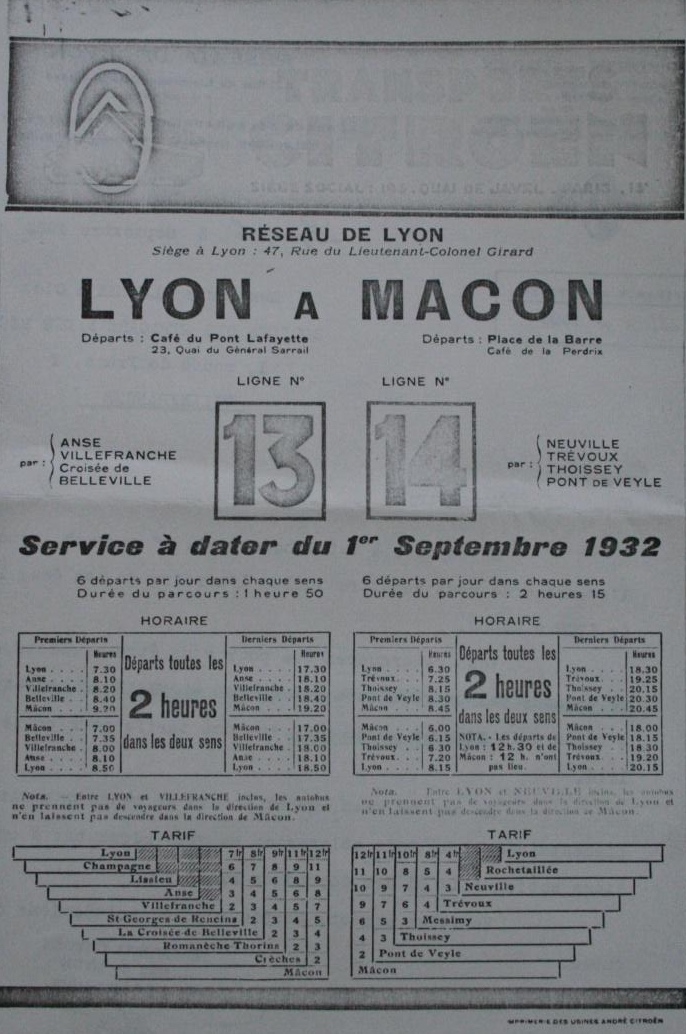
1939
The routes dated from 1932, but from 15 May 1939 Transports Citroën were authorized to operate the Lyon to Chalon service via the direct RN6 road, although with no picking up or setting down between Lyon and Villefranche. This eliminated an inconvenient detour via St. Germain-au-Mont- d’Or and Quincieux. This service was described as a rail replacement service with 8 return journeys before the war – a frequency never again achieved. The road journeys were stopped as a consequence of wartime restrictions (ministerial decision dated 11/09/42), and it was only on 7 May 1945 that a limited service between Chalon and Mâcon was reintroduced – just 2 returns daily.
1946
Citroën was anxious to have the full Lyon-Le Creusot service reinstated as soon as possible. On 14 March, the Comité Technique des Transports du Rhône accepted to authorise 2 daily returns, running on only 3 days of the week. Citroên proposed a single return journey, but on 7 days a week. On 29 April 1946, “Le Progrès” reported that Lyon-Le Creusot would start up again with one return Monday to Saturday leaving Lyon at 7h and returning from Le Creusot at 15h30. For this route, it was specified that the vehicles must have petrol engines.
1948
In March, Citroën said they now had sufficient vehicles available to reinstate the Lyon-Mâcon-Chalon route (127km return) via the N6 providing 4 daily returns.
Their request was refused as the Comité Technique decided that there was insufficient fuel available to cover the mileage – fuel was still rationed at the time.
In April, to support their request, Citroën Lyon provided statistics on their daily activity (see photo below). In 1948, they were running only 36.32% of the mileage run in 1939 (and in January 1943 they had been running just 8.2% of 1939 mileage). They felt they had been particularly hard done by as other operators had had services restored while having lost little of their pre-war mileage! But the Comité maintained its refusal on 11 June 1948, adding to their arguments that the existence of the SNCF service duplicating the route reduced the priority of a road-based service.
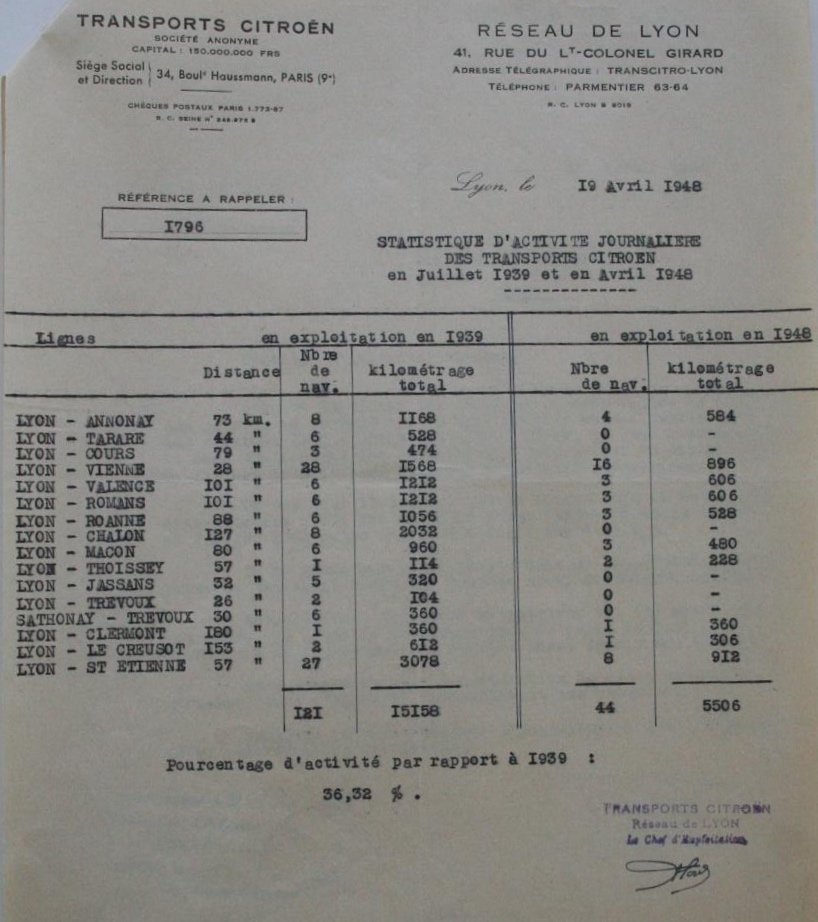
In August the Ministry of Transport became involved, as a result of comments made by Citroën to the département of Saône-et-Loire upon the creation of a market service from Mâcon to Romanèche-Thorins.
Citroën were now willing to reduce their demand to 2 returns instead of 4, and the Saône-et-Loire département was apparently willing to allocate the fuel for one of those two return journeys!
Consequently, the Comité Technique départemental du Rhône agreed to this at its next meeting on 24 September, subject to the stipulation that ‘gasoil’ (diesel) would be used. So ligne 12 started up again on 4 November 1948 (journey time 3h30).
1948
– ligne 12 Timetable Lyon - Mâcon - Chalon
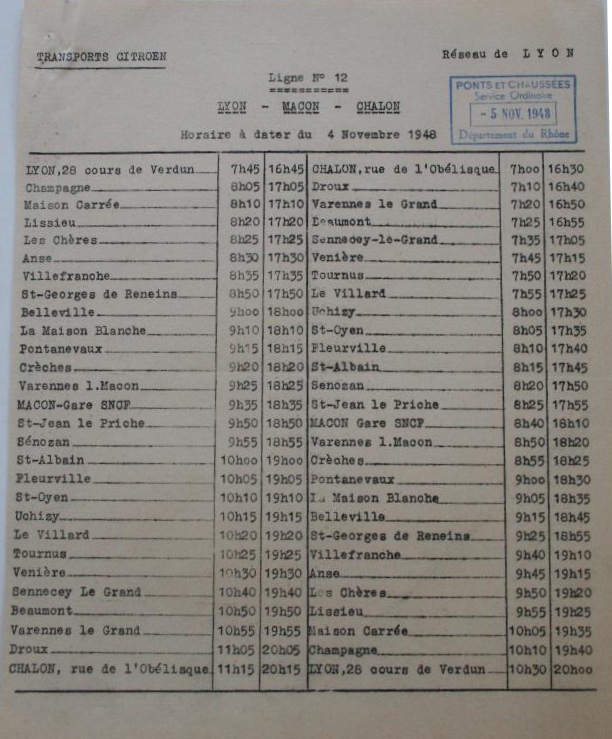
Citroën complained that the 2 returns were insufficient (overcrowding) and requested a third. The timings would become:
Departures from
Lyon 7h
9h30 16h45
Departures from Chalon 7h 14h 16h45
This time, there was opposition from the Ponts & Chaussées in Saône
et Loire and from the SNCF, and it would seem that the authorization
was finally limited to a single return on the Mâcon – Chalon section of
the route.Departures from Chalon 7h 14h 16h45
So now Citroën Lyon was operating:
Lyon-Villefranche-Mâcon-Chalon-Le
Creusot (lignes 12 & 24)
Lyon-Thoissey-Macon (ligne 14), and
Mâcon-Châlon
Lyon-Thoissey-Macon (ligne 14), and
Mâcon-Châlon
On 14 December 1950, the Ministry of Transport threw a spanner in the works – they considered that the increased frequency could not be implemented until a tariff agreement with the SNCF had been made. The bus company was undercutting rail fares, and if no mutual agreement could be reached, then the Ministry would impose a decision.
The differences in fares were:
Lyon to Mâcon SNCF full fare 3rd class 289 FRF Citroën 170 FRF (2F50 per km)
Lyon to Chalon SNCF full fare 3rd class 529 FRF Citroën 320 FRF (2F50 per km)
In November 1950 there was a complaint from St. Georges- de- Renein, a village near Belleville, that Citroën no longer stopped in the village. The company appeared to reverse its decision on 20 December.
1952
This time, in April, Citroën requested a return to the pre-war figure of 8 daily returns to Chalon. But curiously it was only four months later on 12 August that the earlier third Lyon-Chalon return was finally authorized, and the timings had been modified:
Departures from Lyon 7h30 9h30 17h
Departures from Chalon 7h 14h 16h30
St. Georges- de- Renein was once again not served. This time Citroën stated that it was a consequence of an old co-operation agreement with Autocars Planche, who when consulted, refused to waive the terms of the agreement. St Georges said they had only:
One morning and one evening train.
A Planche service from Villefranche to Belleville at 7h, 12h and 19h
A Citroën vehicle at 8h but the other Citroën services did not stop
A Planche service from Villefranche to Belleville at 7h, 12h and 19h
A Citroën vehicle at 8h but the other Citroën services did not stop
1953
It took until 16 April 1953 for the St. Georges situation to be resolved. Planche would supply services stopping at St Georges at 10h02 and 17h02 towards Belleville, and at 10h28 and 17h28 towards Villefranche with connections to Lyon.
1955
The new RHONE transport plan was in the making, and a study was made of the Lyon-Mâcon-Chalon (Le Creusot) corridor, incorporating SNCF journeys on Chaix table n° 500.
In 1955/1956:
Lyon to Le Creusot had two Citroën departures from Le Creusot – at 07.00 and 16.00, and two arrivals at Le Creusot at 11.40 and 20.40.
Lyon to Chalon had the three returns daily, whilst the SNCF provided 10 timings between Lyon and Chalon.
Citroën’s 1952 request to be allowed to operate 8 times daily to Chalon was still in the pending tray.
1960
A fatal accident occurred on 22 December 1960, at Champagne-au-Mont-d’Or. A pedestrian, crossing the road, was hit by vehicle 4477AF69, and died of her injuries.
1962
By a ministerial decision of 7 December 1961, a fourth return on the 12 Lyon-Chalon was added as from 12 March 1962. An improvement but not what Citroën wanted.
1975
1975
Timetable Ligne 14
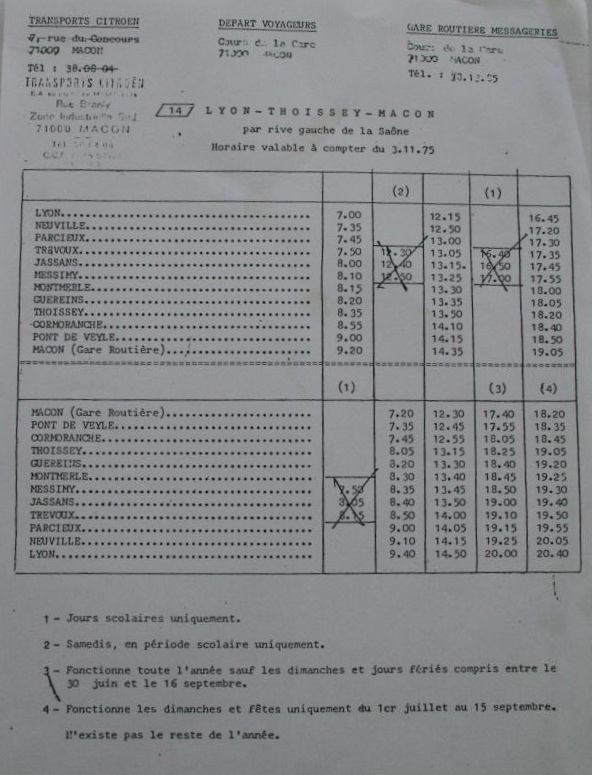
Fourteen years had passed, and times had changed. Rather than seeking extra services, on 20 April, Transports Citroën now wrote of loss of passenger numbers and consequent financial losses. With effect from 9 May, they cut out two timings on Sundays:
Le Creusot 7h > Lyon 10h55
Lyon 16h > Le Creusot 19h55
Lyon 16h > Le Creusot 19h55
Company headed notepaper was now CITER – Transports Citroën.
1979
Transports Citroën had now become TV-CFIT – Compagnie Française Industrielle de Transport. This change is believed to have happened on 8 March 1977.
On 24 December 1979, notice was given of a restructuring of the network – both organization and routes.
Chalon-sur-Saône operating centre, whilst retaining Saône-et-Loire routes
5 Chalon to
Bourg en Bresse
7 Chalon to Lons le Saunier
19 Mâcon to Paray le Monial
22 Mâcon to Bourg-en-Bresse
would also take over routes 12, 14 and 24 from Lyon. Needless to say,
downsizing was the order of the day.7 Chalon to Lons le Saunier
19 Mâcon to Paray le Monial
22 Mâcon to Bourg-en-Bresse
The 12, Lyon - Mâcon -Chalon, currently 3 daily full returns plus one Mâcon- Chalon return as we have seen earlier, would be reduced to just 2 daily returns from Lyon to Mâcon! The outer section Mâcon to Chalon would be left to the 24.
The 24 would no longer serve Lyon- Mâcon but be reduced to Mâcon- Le Creusot, taking it out of the responsibility of the Rhône Dept.
In other words, the CFIT was splitting the route into two halves.
But CFIT bitterly complained to the Rhône, asking them to review the ban on picking up in Villefranche. For several years, Citroën and Planche had been at loggerheads. Planche objected in detail to every change in timetable or itinerary that CFIT proposed. This protection for Planche was originally part of an agreement whereby Planche would buy its buses from Citroën, which was no longer the case.
1980
« April 1980 – L’AVENIR DES
LIGNES REGULIERES Réseau Saône et Loire »
This was the title of an internal review by CFIT Saône-et-Loire of the future of its interurban network.
The main conclusions were:
- Timetables were too complicated
for most passengers, changed too often and were not well distributed
- Frequencies and timings – particularly on long routes, did not allow sufficient time in the town of destination, or to make return trips in half a day
- The buses were too slow – the maximum “vitesse commerciale” was 35 kph – with routes of 2h and more – 4 hours for Lyon-Le Creusot.
- There was no coordination of rail and road
- Frequencies and timings – particularly on long routes, did not allow sufficient time in the town of destination, or to make return trips in half a day
- The buses were too slow – the maximum “vitesse commerciale” was 35 kph – with routes of 2h and more – 4 hours for Lyon-Le Creusot.
- There was no coordination of rail and road
However, ideas for the new network were neither numerous nor clear, the main point seeming to be that transport of schoolchildren and salaried commuters should be the main targets.
1981
Timetables
lignes 12 and 24 – in fact the tables are identical, giving timings for
both routes.
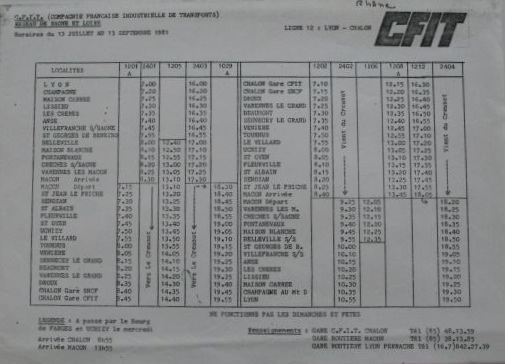
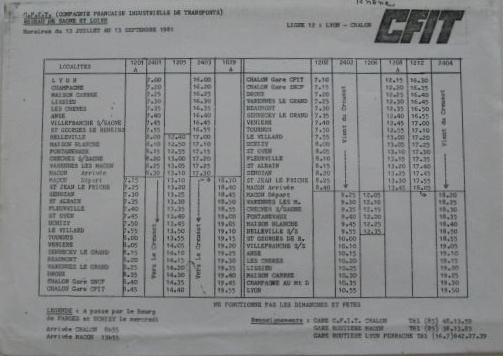
1982
On 24 August 1982, TV-CFIT, Réseau de Châlons sur Saône, wrote to the DDE Lyon.
In 1981 there had been reductions in frequencies on the 12 & 24, but the services were still loss-making and the Mâcon – Le Creusot section of route 24 would be abandoned as of 1 September 1982. It is assumed from this that the threats in 1979 had not been fully implemented.
The CFIT also envisaged closing down route 14 Lyon-Thoissey-Mâcon by 31 December.
1983
Before things could go much further, on 7 July 1983 CFIT sold the Val de Saône services by separate contracts to Secam and CVS – Cars du Val de Saône.
CVS was an Sarl set up with a capital of 50,000 FRF, with depot and head office at rented premises at 28 rue Alsace Lorraine, 71100 Châlons - RCS B 328 162 987. The initial shareholders were:
45,000 FRF Mr Michel
Petit, Director of the Régie des Transports de Saône et Loire
2,000 FRF Mr René Bamet
2,000 FRF Mr Henri Puissilieux
1,000 FRF Mr Georges Rozans
2,000 FRF Mr René Bamet
2,000 FRF Mr Henri Puissilieux
1,000 FRF Mr Georges Rozans
The CFIT – CVS contract covered mainly the non-Rhône operations. CVS took over 16 staff (of which 13 were drivers, and two were maintenance staff) at Mâcon and 21 staff, including 13 drivers, at Chalon. The sale price was 50,000 FRF.
As at 7 July, SECAM was an SARL with a capital of 200,000 FRF. It was based at St Jean D’Ardières (69) and run by Robert Maisonneuve (RCS B 315 384 867).
The CFTI – SECAM contract covered the remnants of the Rhône routes – 2 daily returns on Lyon –Mâcon- Chalon and the 2 daily returns on the Lyon- Mâcon section of Lyon - Le Creusot. (routes 12 & 24). Secam took on 10 staff – 7 drivers, two mechanics and an office girl.
The SECAM sale also included route 14 and the 22 Mâcon to Bourg-en-Bresse.
CVS
informs the Comité Technique
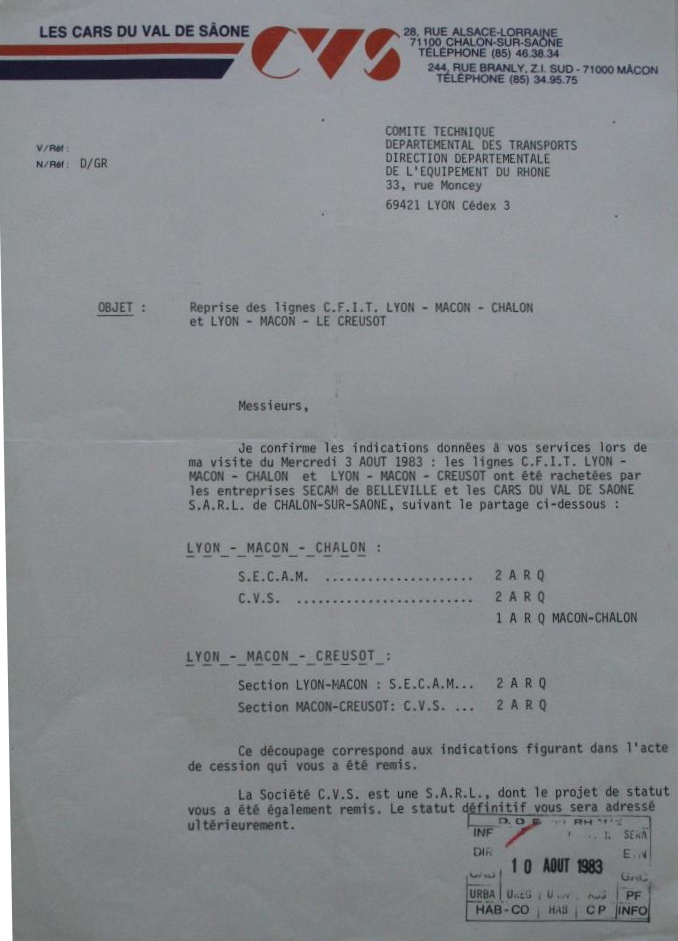
Planche was still as virulent and vituperative as before in defending its territory. And both CVS and SECAM spent some time getting to know the administration – 9 letters from CVS and 10 from SECAM in 1983 addressed to the Direction de l’Equipement (DDE) in Lyon, concerning minor misunderstandings.
But that was no longer CFIT’s problem. Clive D’EATH – 22/04/2017
| DORSET
(RURAL) |
DORSET (URBAN) | SOMERSET |
WILTSHIRE |
HAMPSHIRE |
| FAROE ISLANDS | FRANCE (NATIONAL) | FRANCE (REGIONAL) | ISLE
OF SKYE |
LINCOLNSHIRE |